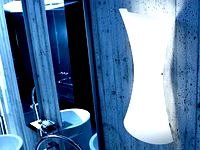Guiding while delighting
Outdoor landscapes – from public parks to university
campuses – can be transformed through thoughtfully
designed lighting plans that balance aesthetics and
functionality.
Landscape lighting is critical for making these spaces
useful, not to mention safer, after dark. But it’s also
essential that the lighting design highlights the identity
of a place as well as its uses – and helps lend form and
ambience to the landscape architecture. When lighting is
integrated into landscape planning from a project’s earli-
est phases, the overall impact of the completed space is
always dramatically enhanced.
Light bollards, for instance, are discreet little helpers that
can illuminate steps, highlight walkways, and indicate
level changes. They ensure visibility next to paths and
passages so that we can be safe in the dark. Thanks to
their low height, they create a comfortable and non-in-
trusive atmosphere and do not interrupt our view of our
surroundings. Post tops, on the other hand, focus less on
creating a sense of intimacy and more on broad illumi-
nation that enhances our awareness of our location. And
wall-mounted outdoor lights accentuate architectural
elements – and show us to our destinations. All these
lighting elements work in concert to create light layering
that addresses both our aesthetic and practical needs as
darkness falls.







